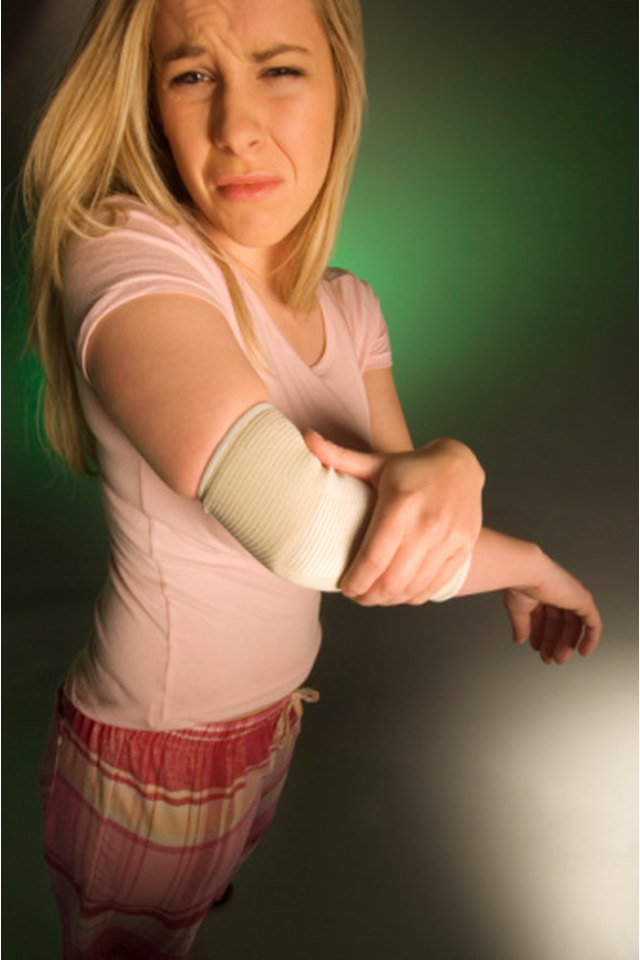How to Play Golf With Golfer's Elbow

Your tendons connect the muscles in your elbow to your elbow bones. When you play golf, the repeated gripping of the club can cause your tendons to become inflamed on the inside of your elbow. The condition is called medial epicondylitis. Symptoms include pain that extends down the forearm and weakness when gripping a club. If left untreated, the tendons can become torn, which can necessitate surgical repair in some instances. While it is possible to still play golf with golfer’s elbow, it’s important to take steps toward recovery.
Take an anti-inflammatory medication such as aspirin, ibuprofen, naproxen or acetaminophen as directed daily. These medications help to constrict inflamed blood vessels that lead to swelling and pain.
Apply heat using a heating pad to your elbow before you play golf. The heat will help to loosen the tendons and muscles in your forearm, reducing pain when you play. Apply for 10 to 15 minutes.
Stretch the forearm muscles before beginning your game. One stretch involves standing an arm’s length away from a wall. Place your palm, fingers down, on the wall, pressing your palm toward the wall. If your tendons are especially tense, you may not be able to place the hand flat. Hold this position for 30 seconds, then release. Repeat two to three times.
Wrap the elbow in a compression bandage or wear an elbow brace while you play. This bandage type helps to isolate the forearm muscles, reducing the amount of strain placed on the muscles when you play golf.
Ice the affected area using an ice pack or create your own pack by putting ice cubes in a plastic bag wrapped with a protective towel. Place the pack on the inner portion of the elbow and leave on for 15 to 20 minutes. Repeat several times throughout the day to reduce inflammation in the tendon.
Practice kinetic chain exercises when you are not playing golf to strengthen the muscles of the elbow and wrist. Hold a 1- to 2-pound weight in the hand you typically swing the club with. Practice your swing holding the weight while tightening the abdomen and back muscles.
Tips
When you experience an initial flare-up of golfer’s elbow, it’s best to rest the elbow for at least one to two weeks to give your tendons time to heal. You also should avoid playing tennis because it affects similar tendons.
Warnings
If your golfer’s elbow does not respond to over-the-counter treatments, seek medical attention. Your physician can recommend physical therapy exercises, prescribe medications or give you a cortisone shot to reduce inflammation.
References
- UpToDate: Elbow Tendinopathy
- NYU Langone Medical Center: Medial Epicondylitis
- SportsMD: What Is Golfer's Elbow?
- Vaquero-picado A, Barco R, Antuña SA. Lateral epicondylitis of the elbow. EFORT Open Rev. 2016;1(11):391-397. doi:10.1302/2058-5241.1.000049
- Amin NH, Kumar NS, Schickendantz MS. Medial epicondylitis: evaluation and management. J Am Acad Orthop Surg. 2015;23(6):348-55. doi:10.5435/JAAOS-D-14-00145
- Blackwell JR, Hay BA, Bolt AM, Hay SM. Olecranon bursitis: a systematic overview. Shoulder Elbow. 2014;6(3):182-90. doi:10.1177/1758573214532787
- Truong J, Ashurst JV. Septic Bursitis. Treasure Island, Fl: StatPearls Publishing; 2019.
- Varacallo M, Mair SD. Proximal Biceps Tendinitis and Tendinopathy. Treasure Island, Fl: StatPearls Publishing; 2019.
- Bellapianta JM, Lavelle WF, Lavelle ED, Onyedika I, Economedes D, Whipple R. Hand Pain. Current Therapy in Pain. 2009:156-167. doi:10.1016/b978-1-4160-4836-7.00021-3
- Moradi A, Ebrahimzadeh MH, Jupiter JB. Radial Tunnel Syndrome, Diagnostic and Treatment Dilemma. Arch Bone Jt Surg. 2015;3(3):156-62.
- Saeed W, Waseem M. Elbow Fractures Overview. Treasure Island, Fl: StatPearls Publishing; 2019.
- Athwal GS. Elbow Dislocation - OrthoInfo - AAOS. OrthoInfo: American Academy of Orthopaedic Surgeons. Oct 2017.
- Bursitis. MedlinePlus. Sept 12, 2019.
- Harvard Health Publishing. The importance of stretching. Harvard Health. Sept 2013.
- Tennis Elbow (Lateral Epicondylitis) - OrthoInfo - AAOS. OrthoInfo: American Academy of Orthopaedic Surgeons. Jul 2015.
- Shah CM, Calfee RP, Gelberman RH, Goldfarb CA. Outcomes of rigid night splinting and activity modification in the treatment of cubital tunnel syndrome. J Hand Surg Am. 2013;38(6):1125-1130.e1. doi:10.1016/j.jhsa.2013.02.039
- Biceps Tendinitis - OrthoInfo - AAOS. OrthoInfo: American Academy of Orthopaedic Surgeons. Feb 2016.
- Kinaci A, Neuhaus V, Ring D. Surgical procedures of the elbow: a nationwide cross-sectional observational study in the United States. Arch Bone Jt Surg. 2015;3(1):13-8.
- American Academy of Orthopedic Surgeons. (n.d.). Elbow Arthroscopy.
- Kane SF. Evaluation of Elbow Pain in Adults. Am Fam Physician. 2014 Apr 15;89(8):649-57.
- O'Connor FG. (2018). Evaluation of elbow pain in adults. Fields KB, ed. UpToDate. Waltham, MA: UpToDate Inc.
- Sources:American Academy of Orthopedic Surgeons (n.d.). Elbow Fractures in Children.
Tips
- When you experience an initial flare-up of golfer's elbow, it's best to rest the elbow for at least one to two weeks to give your tendons time to heal. You also should avoid playing tennis because it affects similar tendons.
Warnings
- If your golfer's elbow does not respond to over-the-counter treatments, seek medical attention. Your physician can recommend physical therapy exercises, prescribe medications or give you a cortisone shot to reduce inflammation.
Writer Bio
Rachel Nall began writing in 2003. She is a former managing editor for custom health publications, including physician journals. She has written for The Associated Press and "Jezebel," "Charleston," "Chatter" and "Reach" magazines. Nall is currently pursuing her Bachelor of Science in Nursing at the University of Tennessee.
